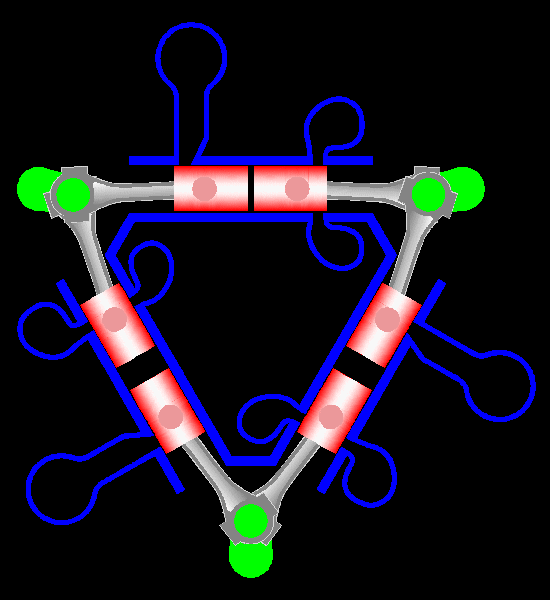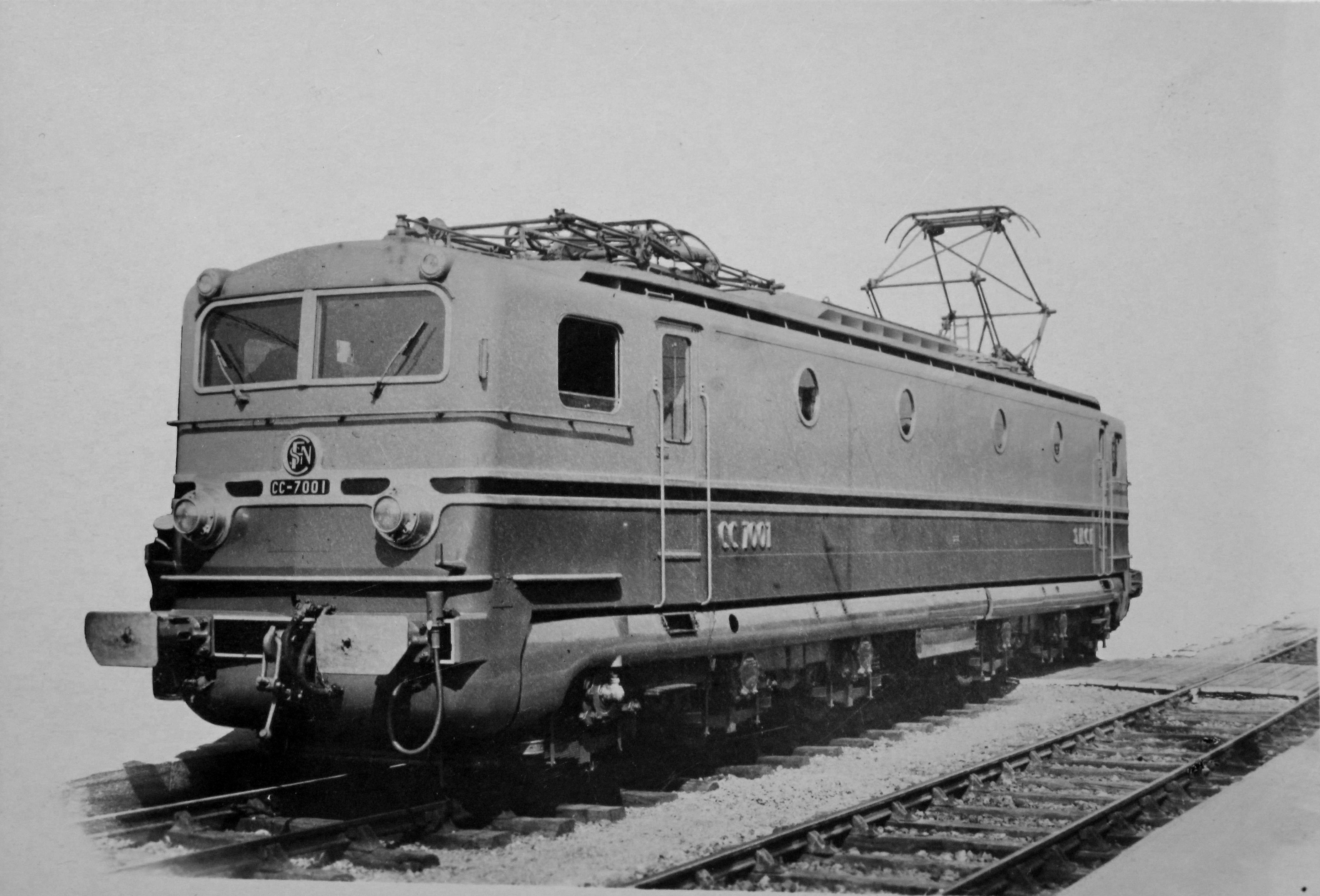|
SNCF 2D2 9100
The 2D2 9100 was a class of electric locomotives operated by the SNCF in France, introduced in 1950. They were a development of the pre-war :en:SNCF 2D2 5500, 2D2 5500, built during the post-war push for increased :en:railway electrification system, electrification. Design The class was an updated development of the pre-war :en:SNCF 2D2 5500, 2D2 5500 built for the Chemins de fer de Paris à Orléans et du Midi, PO-Midi. Mechanically similar, they incorporated a number of improvements to the electrical system to give smoother control. The 9100 represented the ultimate of the rigid-framed electric locomotive; later designs would be bogie (locomotive), bogie designs. The design had originated on the :en:Compagnie du chemin de fer de Paris à Orléans, Paris-Orléans with the two class locomotives of 1925. These had four traction motors, one per axle, driving through Buchli drives and following Swiss practice. They were considered to be more reliable in service than other PO ele ... [...More Info...] [...Related Items...] OR: [Wikipedia] [Google] [Baidu] |
Compagnie Électro-Mécanique
Compagnie Électro-Mécanique (CEM) was a French electrical engineering manufacturer based in Paris, Le Havre, Lyon, Le Bourget, Nancy, France, Nancy, Dijon. It was a subsidiary company of Brown, Boveri & Cie. Production The company produced DC motors, AC motors, Electric generator, generators, turbines, transformers and locomotive, railway locomotives. Examples of railway locomotives included SNCF Class C 61000 and SNCF Class CC 65500. Acquisition by Alsthom It was acquired by Alstom, Alsthom in 1983. References Alstom {{France-rail-transport-stub ... [...More Info...] [...Related Items...] OR: [Wikipedia] [Google] [Baidu] |
Napier Deltic
The Napier Deltic engine is a British opposed-piston valveless, supercharged uniflow scavenged, two-stroke diesel engine used in marine and locomotive applications, designed and produced by D. Napier & Son. Unusually, the cylinders were disposed in a three-bank triangle, with a crankshaft at each corner of the triangle. The term Deltic (meaning "in the form of the Greek letter (capital) delta") is used to refer to both the Deltic E.130 opposed-piston, high-speed diesel engine and the locomotives produced by English Electric using these engines, including its demonstrator locomotive named ''DELTIC'' and the production version for British Railways, which designated these as the Class 55. A single, half-sized, turbocharged Deltic power unit also featured in the English Electric-built Type 2 locomotive, designated as the Class 23. Both locomotive and engine became better known as the "Baby Deltic". History and design The Deltic story began in 1943 when the British Admiral ... [...More Info...] [...Related Items...] OR: [Wikipedia] [Google] [Baidu] |
Fives-Lille Locomotives
Fives-Lille was a French engineering company located at Fives, a suburb of Lille. It is now part of the Fives Group. History The company began as in 1861. The founders and were of Belgian origin. The company later entered into a joint venture with Société J. F. Cail & Cie. This co-operation led to expansion and the creation of several factories. One plant, located in the district of Fives, near Lille, specialized in the construction of rails and steam locomotives. Another plant in Givors on the Rhône specialized in wheelsets for railway rolling stock The term rolling stock in the rail transport industry refers to railway vehicles, including both powered and unpowered vehicles: for example, locomotives, Railroad car#Freight cars, freight and Passenger railroad car, passenger cars (or coaches) .... The business developed and became, in 1865, the ''Compagnie de Fives - Lille'', then in 1868, the limited company ''Compagnie de Fives-Lille pour constructions mécaniques ... [...More Info...] [...Related Items...] OR: [Wikipedia] [Google] [Baidu] |
1500 V DC Locomotives
Fifteen or 15 may refer to: *15 (number) *one of the years 15 BC, AD 15, 1915, 2015 Music * Fifteen (band), a punk rock band Albums * ''15'' (Buckcherry album), 2005 * ''15'' (Ani Lorak album), 2007 * ''15'' (Phatfish album), 2008 * ''15'' (Tuki album), 2025 * ''15'' (mixtape), a 2018 mixtape by Bhad Bhabie * ''Fifteen'' (Green River Ordinance album), 2016 * ''Fifteen'' (The Wailin' Jennys album), 2017 * ''Fifteen'', a 2012 album by Colin James Songs * "Fifteen" (song), a 2008 song by Taylor Swift *"Fifteen", a song by Harry Belafonte from the album '' Love Is a Gentle Thing'' *"15", a song by Rilo Kiley from the album ''Under the Blacklight'' *"15", a song by Marilyn Manson from the album ''The High End of Low'' Other media * ''15'' (film), a 2003 Singaporean film * ''Fifteen'' (TV series), international release name of ''Hillside'', a Canadian-American teen drama * "Fifteen" (''Runaways''), an episode of ''Runaways'' *Fifteen (novel), a 1956 juvenile fic ... [...More Info...] [...Related Items...] OR: [Wikipedia] [Google] [Baidu] |
SNCF Locomotives
The Société nationale des chemins de fer français (, , SNCF ) is France's national State-owned enterprise, state-owned railway company. Founded in 1938, it operates the Rail transport in France, country's national rail traffic along with that of Monaco, including the TGV, on France's high-speed rail network. Its functions include operation of railway services for passengers and freight (through its subsidiaries SNCF Voyageurs and Rail Logistics Europe), as well as maintenance and signalling of rail infrastructure (SNCF#Divisions, SNCF Réseau). The railway network consists of about of route, of which are high-speed lines and electrified. About 14,000 trains are operated daily. In 2010 the SNCF was ranked 22nd in France and 214th globally on the Fortune Global 500, ''Fortune'' Global 500 list. It is the main business of the SNCF Group, which in 2020 had €30 billion of sales in 120 countries. The SNCF Group employs more than 275,000 employees in France and around the worl ... [...More Info...] [...Related Items...] OR: [Wikipedia] [Google] [Baidu] |
Standard Gauge Electric Locomotives Of France
Standard may refer to: Symbols * Colours, standards and guidons In military organizations, the practice of carrying colours, standards, flags, or guidons, both to act as a rallying point for troops and to mark the location of the commander, is thought to have originated in Ancient Egypt some 5,000 year ..., kinds of military signs * Heraldic flag, Standard (emblem), a type of a large symbol or emblem used for identification Norms, conventions or requirements * Standard (metrology), an object that bears a defined relationship to a unit of measure used for calibration of measuring devices * Standard (timber unit), an obsolete measure of timber used in trade * Breed standard (also called bench standard), in animal fancy and animal husbandry * BioCompute Object, BioCompute Standard, a standard for next generation sequencing * De facto standard, ''De facto'' standard, product or system with market dominance * Gold standard, a monetary system based on gold; also used metap ... [...More Info...] [...Related Items...] OR: [Wikipedia] [Google] [Baidu] |
Monument Historique
() is a designation given to some national heritage sites in France. It may also refer to the state procedure in France by which national heritage protection is extended to a building, a specific part of a building, a collection of buildings, a garden, a bridge, or other structure, because of their importance to France's architectural and historical cultural heritage. Both public and privately owned structures may be listed in this way, as well as movable objects. there were 44,236 monuments listed. The term "classification" is reserved for designation performed by the French Ministry of Culture for a monument of national-level significance. Monuments of lesser significance may be "inscribed" by various regional entities. Buildings may be given the classification (or inscription) for either their exteriors or interiors. A monument's designation could be for a building's décor, its furniture, a single room, or even a staircase. An example is the classification of the déco ... [...More Info...] [...Related Items...] OR: [Wikipedia] [Google] [Baidu] |
:en:SNCF Class CC 7100
SNCF's CC 7100 class are part of a series of electric locomotives built by Alstom. The prototype 'CC 7000' (7001 & 7002) were built in 1949 and the production series locomotives CC 7101-CC 7158 followed during 1952–1955. Two of the class are notable for setting world rail speed records: CC 7121 reaching on 21 February 1954, and CC 7107 reaching on 28/29 March 1955. History The CC 7100 class were the first SNCF high-speed locomotives in which all the axles were motorized, i.e. with powered bogies rather a rigid frame. As delivered their top speed was . The CC 7100 were contemporaries of the 2D2 9100 for express passenger service on the PLM. From the outset it was apparent that bogie locomotives represented the future and so only a third of the anticipated 2D2s were built, in favour of the CC 7100. Speed records During the 1950s, SNCF's experimental investigations into high-speed rail saw some CC 7100 class locomotives specially-modified for operation at speeds far higher ... [...More Info...] [...Related Items...] OR: [Wikipedia] [Google] [Baidu] |
Bogie
A bogie ( ) (or truck in North American English) comprises two or more Wheelset (rail transport), wheelsets (two Railroad wheel, wheels on an axle), in a frame, attached under a vehicle by a pivot. Bogies take various forms in various modes of transport. A bogie may remain normally attached (as on many railroad cars and semi-trailers) or be quickly detachable (as for a dolly (trailer), dolly in a road train or in railway bogie exchange). It may include Suspension (vehicle), suspension components within it (as most rail and trucking bogies do), or be solid and in turn be suspended (as are most bogies of continuous track, tracked vehicles). It may be mounted on a swivel, as traditionally on a railway carriage or locomotive, additionally jointed and sprung (as in the landing gear of an airliner), or held in place by other means (centreless bogies). Although ''bogie'' is the preferred spelling and first-listed variant in various dictionaries, bogey and bogy are also used. Rail ... [...More Info...] [...Related Items...] OR: [Wikipedia] [Google] [Baidu] |
Co-Co Locomotives
Co-Co is the wheel arrangement for Diesel locomotive, diesel and electric locomotives with two six-wheeled bogies with all axles powered, with a separate traction motor per axle. The equivalent UIC classification of locomotive axle arrangements, UIC classification (Europe) for this arrangement is Co′Co′, or C-C for AAR wheel arrangement#C-C, AAR (North America). Use Co-Cos are most suited to freight work as the extra wheels give them good Traction (engineering), traction. They are also popular because the greater number of axles results in a lower axle load to the track. History The first mainline diesel-electric locomotives were of Bo-Bo arrangement. As they grew in power and weight, from 1937 the EMD E-units used an A1A-A1A layout with six axles to reduce axle load. After WWII, the British London, Midland and Scottish Railway, LMS ordered British Rail Class D16/1, two prototype locomotives with some of the first Co-Co arrangements. The first C-C design recorded w ... [...More Info...] [...Related Items...] OR: [Wikipedia] [Google] [Baidu] |
Paris–Marseille Railway
The railway from Paris to Marseille is an 862-kilometre long railway line, that connects Paris to the southern port city of Marseille, France, via Dijon and Lyon. The railway was opened in several stages between 1847 and 1856, when the final section through Lyon was opened. The opening of the LGV Sud-Est high speed line from Paris to Lyon in 1981, the LGV Rhône-Alpes in 1992 and the LGV Méditerranée in 2001 has decreased its importance for passenger traffic. Route The Paris–Marseille railway leaves the Gare de Lyon in Paris in southeastern direction. It crosses the river Marne at Charenton-le-Pont, and follows the right Seine bank upstream until Crosne, where it follows a course east of the Forest of Sénart. It crosses the Seine near Melun and follows the left Seine bank upstream, along the Forest of Fontainebleau. Beyond Montereau-Fault-Yonne, the railway follows the left Yonne bank upstream. At Migennes the Yonne is crossed, and the small rivers Armançon, Br ... [...More Info...] [...Related Items...] OR: [Wikipedia] [Google] [Baidu] |





